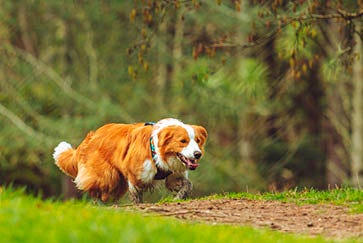How to keep your dog safe at the beach
As the temperatures rise, so too does our desire to set up for a day at the beach with our canine friends. In this article, we tackle everything you should consider when bringing your pooch to the beach and the hazards to watch out for.
On those long days and warm nights, there’s nothing better than seeing happy dogs at the beach. Many dogs love a trip to the beach, but it’s always important to be fully prepared and have safety top of mind. There are many unfamiliar sights, sounds and smells for your dog to explore, and you want to ensure you make it a positive and safe experience for all.
Preparation is key!
Before heading out to a fun day at the beach with your four-legged friend, get an idea of the weather first and make sure the day is not going to be too hot. It’s important to avoid the hottest time of 10am-3pm in the summer. Bring plenty of fresh water (and don’t forget the bowl!), poop-bags, an umbrella for shade and a long lead with you. Some dogs may also benefit from a dog rashie vest or doggy sunscreen, especially if they have delicate pale or pink skin.
Follow the rules
Make sure you take your dog to a dog-friendly beach. You can find out whether the beach you’re planning to visit is dog friendly by looking online or by checking for signs when you arrive. Just like any other dog walk, always clean up and remove the waste after your pup – dog friendly beaches often have poo bins readily available to keep the beach clean, safe and enjoyable for everyone!
Slow and steady
Don’t assume your dog can swim, as all dogs have to learn just like us. Some breeds are naturally strong swimmers, but other breeds, such as corgis and pugs, are not. So if you are taking your pet to the beach for the first time, make sure you have a dog floatation vest for them.
When teaching your dog to swim always start and end on a positive note, with plenty of praise, treats and games to ensure you are all having fun! If your pet doesn’t feel like going in the water, that’s ok! As long as the experience is positive for them overall, they may be brave enough to try it next time. Ensuring the trip is safe and fun will set you and your pet up for a sea of success.
To keep your pet safe in the water, here’s our top swimming tips:
- Know the area where you are swimming, as you need to be familiar with the location (e.g. rocks, depth etc), or ask someone there before your pet jumps in.
- Don’t ever force your dog into the water, it will only increase their fear, and may prevent them from entering the water in the future.
- Keep an eye on the tide and the current, you do not want your pet to get caught in a sea rip or a sandbar.
- Always stay close to your pet, you need to know their limits.
- Praise them for drinking normal water and deter them from drinking sea water; it can cause vomiting and diarrhoea.
- If you are going on a boat, a pet life jacket is highly recommended.
- Have fun, if you're having fun it will calm your pet’s nerves and let them relax to have fun too.

A day at the beach with your four-legged friend is the perfect fun day out – however, there are a few hazards that have the potential to dampen the day. Here are the top 10 dangers to be aware of before taking your dog to the beach:
1. Heat stroke:
While the weather might feel cooler in the sea breeze, don’t forget that temperatures can still quickly soar – especially in the summer months. Always protect your pup from heat stroke by making sure they have a good area of shade to sit in and fresh water to drink – you can even try making your own DIY sun shelter while out and about!

2. Broken glass or sharp objects:
Broken glass or sharp objects that can be hidden in the sand or amongst pebbles, can cut the pad of your dog’s paw if stepped on. Make sure you keep a first aid kit handy and keep an eye out for hazards that might cause an injury. If your dog is unlucky enough to get a cut, make sure you keep it clean by washing it well with fresh water and try to cover the wound, before taking a trip to the vet.
3. Fishing hooks:
If you’re visiting a beach that’s popular for fishing watch out for fish hooks. Dogs are often tempted to swallow the shiny lure - especially if there’s a piece of tasty bait attached to them. Fishing hooks can cause nasty injuries if embedded in their mouth, food pipe or stomach. Dogs can also suffer paw injuries from standing on fish hooks.
4. Sunburn:
Like us, dogs can suffer sunburn. Breeds with short hair or white hair, and pink ears must be particularly careful on hot days. Use a sunscreen made specifically for dogs and avoid those that contain fragrances.
5. Jellyfish:
Dogs are at risk of jellyfish stings not only when swimming, but also by coming into contact with washed up tentacles on the beach. Jellyfish stings can cause great discomfort to your dog and be painful around the eyes, nose, mouth and paws. Jellyfish sting symptoms include: red skin, swelling or hives.

6. Sea slugs:
There are many different species of sea slugs in New Zealand; however Pleurobranchaea maculata is the species which has been linked to dog fatalities on Auckland beaches since 2009. It is currently unknown whether all sea slugs of this species are toxic or whether it is only the ones which are found in the Auckland North Shore and Coromandel area. Sea slugs naturally produce the toxin Tetrodotoxin (TTX) which is also found in pufferfish. If you believe your dog has licked or ingested a sea slug, contact your vet immediately.
7. Seawater:
Drinking salty sea water can give your dog a nasty bout of sickness and/or diarrhoea – and in some cases can make them seriously ill and dehydrated. Always take plenty of fresh tap water, along with a travel bowl to stop your pooch from being tempted to drink water from rock pools, puddles or the sea.

8. Other dogs:
During the times of the day dogs are allowed on beaches in summer, dogs often can be found in higher numbers and are often off-leash. That can be a fun dog park-like experience, but if you don’t know the dogs there, watch out for any signs of aggression.
9. Sand ingestion:
Believe it or not, eating and swallowing sand can actually cause stomach problems for your dog, as the sand can compact in their tummy and cause a blockage. Playing with sandy toys (such as tennis balls) can also cause wearing down of the enamel on their teeth over time.

10. Walking on hot sand:
The sun can heat up the sand to dangerous temperatures. If it’s too hot for you to walk barefoot, then it’s too hot for your dog’s paws.
Most of these dangers are preventable simply by keeping your dog on a leash, making fresh water available at all times, and providing shade. By keeping an eye out for these beach hazards, hopefully your beach day will go smoothly, and everyone will come home tired and happy. If you have questions about keep your dog safe at the beach, speak with your local Animates or Animates Vetcare team.
On those long days and warm nights, there’s nothing better than seeing happy dogs at the beach. Many dogs love a trip to the beach, but it’s always important to be fully prepared and have safety top of mind. There are many unfamiliar sights, sounds and smells for your dog to explore, and you want to ensure you make it a positive and safe experience for all.
Preparation is key!
Before heading out to a fun day at the beach with your four-legged friend, get an idea of the weather first and make sure the day is not going to be too hot. It’s important to avoid the hottest time of 10am-3pm in the summer. Bring plenty of fresh water (and don’t forget the bowl!), poop-bags, an umbrella for shade and a long lead with you. Some dogs may also benefit from a dog rashie vest or doggy sunscreen, especially if they have delicate pale or pink skin.
Follow the rules
Make sure you take your dog to a dog-friendly beach. You can find out whether the beach you’re planning to visit is dog friendly by looking online or by checking for signs when you arrive. Just like any other dog walk, always clean up and remove the waste after your pup – dog friendly beaches often have poo bins readily available to keep the beach clean, safe and enjoyable for everyone!
Slow and steady
Don’t assume your dog can swim, as all dogs have to learn just like us. Some breeds are naturally strong swimmers, but other breeds, such as corgis and pugs, are not. So if you are taking your pet to the beach for the first time, make sure you have a dog floatation vest for them.
When teaching your dog to swim always start and end on a positive note, with plenty of praise, treats and games to ensure you are all having fun! If your pet doesn’t feel like going in the water, that’s ok! As long as the experience is positive for them overall, they may be brave enough to try it next time. Ensuring the trip is safe and fun will set you and your pet up for a sea of success.
To keep your pet safe in the water, here’s our top swimming tips:
- Know the area where you are swimming, as you need to be familiar with the location (e.g. rocks, depth etc), or ask someone there before your pet jumps in.
- Don’t ever force your dog into the water, it will only increase their fear, and may prevent them from entering the water in the future.
- Keep an eye on the tide and the current, you do not want your pet to get caught in a sea rip or a sandbar.
- Always stay close to your pet, you need to know their limits.
- Praise them for drinking normal water and deter them from drinking sea water; it can cause vomiting and diarrhoea.
- If you are going on a boat, a pet life jacket is highly recommended.
- Have fun, if you're having fun it will calm your pet’s nerves and let them relax to have fun too.

A day at the beach with your four-legged friend is the perfect fun day out – however, there are a few hazards that have the potential to dampen the day. Here are the top 10 dangers to be aware of before taking your dog to the beach:
1. Heat stroke:
While the weather might feel cooler in the sea breeze, don’t forget that temperatures can still quickly soar – especially in the summer months. Always protect your pup from heat stroke by making sure they have a good area of shade to sit in and fresh water to drink – you can even try making your own DIY sun shelter while out and about!

2. Broken glass or sharp objects:
Broken glass or sharp objects that can be hidden in the sand or amongst pebbles, can cut the pad of your dog’s paw if stepped on. Make sure you keep a first aid kit handy and keep an eye out for hazards that might cause an injury. If your dog is unlucky enough to get a cut, make sure you keep it clean by washing it well with fresh water and try to cover the wound, before taking a trip to the vet.
3. Fishing hooks:
If you’re visiting a beach that’s popular for fishing watch out for fish hooks. Dogs are often tempted to swallow the shiny lure - especially if there’s a piece of tasty bait attached to them. Fishing hooks can cause nasty injuries if embedded in their mouth, food pipe or stomach. Dogs can also suffer paw injuries from standing on fish hooks.
4. Sunburn:
Like us, dogs can suffer sunburn. Breeds with short hair or white hair, and pink ears must be particularly careful on hot days. Use a sunscreen made specifically for dogs and avoid those that contain fragrances.
5. Jellyfish:
Dogs are at risk of jellyfish stings not only when swimming, but also by coming into contact with washed up tentacles on the beach. Jellyfish stings can cause great discomfort to your dog and be painful around the eyes, nose, mouth and paws. Jellyfish sting symptoms include: red skin, swelling or hives.

6. Sea slugs:
There are many different species of sea slugs in New Zealand; however Pleurobranchaea maculata is the species which has been linked to dog fatalities on Auckland beaches since 2009. It is currently unknown whether all sea slugs of this species are toxic or whether it is only the ones which are found in the Auckland North Shore and Coromandel area. Sea slugs naturally produce the toxin Tetrodotoxin (TTX) which is also found in pufferfish. If you believe your dog has licked or ingested a sea slug, contact your vet immediately.
7. Seawater:
Drinking salty sea water can give your dog a nasty bout of sickness and/or diarrhoea – and in some cases can make them seriously ill and dehydrated. Always take plenty of fresh tap water, along with a travel bowl to stop your pooch from being tempted to drink water from rock pools, puddles or the sea.

8. Other dogs:
During the times of the day dogs are allowed on beaches in summer, dogs often can be found in higher numbers and are often off-leash. That can be a fun dog park-like experience, but if you don’t know the dogs there, watch out for any signs of aggression.
9. Sand ingestion:
Believe it or not, eating and swallowing sand can actually cause stomach problems for your dog, as the sand can compact in their tummy and cause a blockage. Playing with sandy toys (such as tennis balls) can also cause wearing down of the enamel on their teeth over time.

10. Walking on hot sand:
The sun can heat up the sand to dangerous temperatures. If it’s too hot for you to walk barefoot, then it’s too hot for your dog’s paws.
Most of these dangers are preventable simply by keeping your dog on a leash, making fresh water available at all times, and providing shade. By keeping an eye out for these beach hazards, hopefully your beach day will go smoothly, and everyone will come home tired and happy. If you have questions about keep your dog safe at the beach, speak with your local Animates or Animates Vetcare team.








